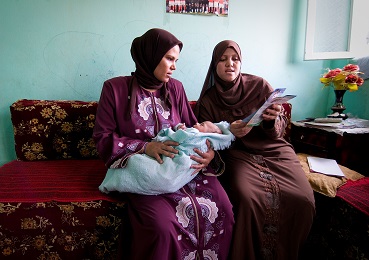River subbasins more depleted than
official figures show
09 April 2024
Published online 22 January 2015
Up to 5,000 Egyptian children a year could be infected by hepatitis C through their mothers.

© Claudia Wiens / Alamy
This vertical transmission is believed to occur during pregnancy, childbirth or during the postpartum period, via blood transfer when breastfeeding through cracked or bleeding nipples, since the virus does not pass through breast milk.
Scientists from the Weill Cornell Medical College in Qatar (WCMC-Q) and the London School of Hygiene & Tropical Medicine in the UK concentrated on statistics from Egypt, which has the highest incidence of HCV worldwide, with an estimated 14.7% of the population carrying the virus and up to 100,000 new infections occurring each year, according to WHO.
The scientists from the Weill Cornell Medical College in Qatar (WCMC-Q) and the London School of Hygiene & Tropical Medicine in the UK focused on Egypt, which has the highest incidence of HCV worldwide, with an estimated 14.7% of the population carrying the virus and up to 100,000 new infections occurring each year, according to WHO.
The study is the first to estimate the number of new infections that result from mother-to-child transmission in any country. The team established a mathematical model based on the 2008 Egypt Demographic and Health Survey (DHS), a nationally-representative study that collected biomarkers of HCV infection. This is the first such survey to include HCV infection in any low and middle income country.
More worrying, the study's findings, published in Hepatology, show that mother-to-child transmission could contribute between 30% and 50% of all new cases in the under five-year age bracket. They also estimated that 7% of married women of reproductive age had HCV in their blood steam in 2008, with a higher infection rate identified in rural areas.
Pregnant women with a high viral load are more likely to infect their infants with HCV compared to those with lower viral loads, and women under the double burden of HCV and HIV infection are the most at risk of infecting their newborns.
“The bulk of mothers with a high viral load are those with a compromised immune system,” explains Manal El Sayed , a paediatrician at Ain Shams University and supervisor of the Egyptian National Committee for Control of Viral Hepatitis. “These women might have been infected with other viruses, or may have suffered from the flu before delivery. If they have HIV and its associated lower immunity, then the chances of transmitting hepatitis C become very high,” she says.
There are definitely opportunities to offer premarital counselling, leading to referral for treatment.
Lenka Benova , from the London School of Hygiene & Tropical Medicine and Weill Cornell Medical College in Qatar, lead author of the study, explains that vertical transmission from mother-to-child has several unique characteristics which make it hard to understand.
“HCV vertical transmission is a rare occurrence. In our previous study, we estimated that between five and 10 in a hundred children born to women with active HCV infection are vertically infected, depending on the mother's HIV co-infection.”
Secondly, she stresses that it takes a long time to determine the infection status among newborns who were vertically exposed to the virus. The current clinical advice is to follow exposed children for 18 to 24 months before diagnosing chronic infection. This is due to the fact that mothers' antibodies in newborns are likely to have cleared after the first year.
“Children have the ability to get rid of the virus at a much higher rate than adults, and by the age of five or six, almost 30% of the really infected children are clear of the virus,” explains El Sayed.
Therefore, any studies to assess the mechanism of vertical transmission need to recruit large numbers of HCV-positive pregnant women and maintain follow-up with their children for several years; which can be logistically difficult and expensive, explains Benova.
Despite decades of primary research, Benova says that no interventions during pregnancy or at the time of delivery have been shown to reduce the risk of HCV vertical transmission. “Treatment with pegylated interferon and ribavirin is contraindicated during pregnancy and is currently not given to children under two years,” she says.
El Sayed adds there is promising research in the pipeline, but answers may be some way off. “In the near future, we will have safe direct antiviral agent drugs that could be taken during pregnancy to completely prevent the transmission, but the clinical trials have not started yet.”
In the meantime, screening and treatment could be offered to women with active HCV before they are pregnant, according to Benova. The DHS study of 2008 found that only 2% of Egyptian women reported ever having been tested for HCV. “There are definitely opportunities to offer premarital counselling, leading to referral for treatment. In children over two years old, early treatment of infection has shown excellent results.”
doi:10.1038/nmiddleeast.2015.15
Stay connected: